Mexican marigold, also known as Mexican tarragon, Mexican mint marigold, or sweet mace, is a heat-loving annual herb native to Mexico and Central America. Belonging to the Asteraceae family, this versatile plant thrives in warmer regions (USDA zones 8–11) and enjoys full sun.
Its flavorful, licorice-scented leaves make it a popular substitute for traditional tarragon in cooking, while its cheerful, golden-yellow, marigold-like blooms add a burst of color to gardens from late summer to autumn. Known by various names such as winter tarragon and Texas tarragon, this herb is a resilient, low-maintenance choice for both herb and ornamental gardens.
Read on to learn how to grow and care for Mexican marigold to make the most of this aromatic, easy-to-grow plant.
| Common name | Mexican Marigold, Mexican Mint Marigold, Mexican Tarragon, Sweet Mace, Sweetscented marigold |
| Botanical name | Tagetes lucida |
| Family | Asteraceae |
| Species | lucida |
| Origin | Mexico to Honduras |
| Life cycle | Annual |
| Plant type | Annual |
| Hardiness zone | 8, 9, 10, 11 |
| Sunlight | Full Sun |
| Maintenance | Low |
| Soil condition | Clay |
| Soil ph | Acid |
| Drainage | Well-Drained |
| Growth rate | Medium |
| Spacing | 12 in. – 3 ft. |
| Flowering period | Fall |
| Height | 6 in. – 2 ft. 6 in. |
| Flower color | Gold, Yellow |
| Leaf color | Green |
| Fruit color | Black |
| Fruit type | Achene |
| Flower benefit | Fragrant |
| Garden style | Cottage Garden |
| Uses | Container |
I. Appearance and Characteristics
Tagetes lucida is a perennial plant native to Mexico and Central America. It is used as a medicinal plant and as a culinary herb. The leaves have a tarragon-like scent, with hints of anise, and it has entered the nursery trade in North America as a tarragon substitute. Common names include sweetscented marigold, Mexican marigold, Mexican mint marigold, Mexican tarragon, sweet mace, Texas tarragon, pericón, yerbaniz, and hierbanís.
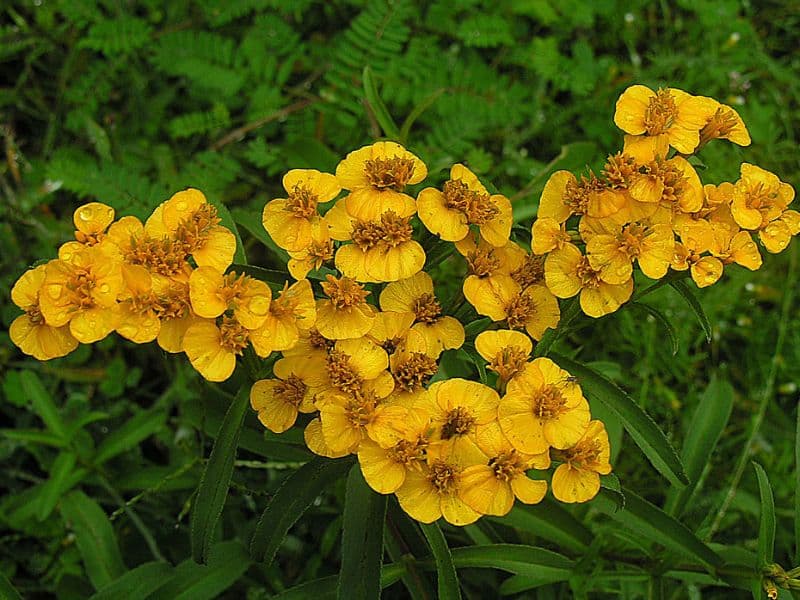
Tagetes lucida grows 45–75 cm (18–30 in) tall and requires full sun to light shade. Depending on the variety or landrace, the plant may be fairly upright, while other forms appear bushy with many unbranching stems. The leaves are linear to oblong, about 7.5 cm (3 in) long, and shiny medium green, not blue-green as in French tarragon (Artemisia dracunculus var. sativa). In late summer it bears clusters of small golden yellow flower heads on the ends of the stems. The flower heads are about 15 mm (1⁄2 in) across and have 3–5 golden-yellow ray florets. The flowers are hermaphroditic (have both male and female organs) and are pollinated by insects.
II. How to Grow and Care
Watering
Although Mexican tarragon plants are relatively drought tolerant, the plants are bushier and healthier with regular irrigation. Water only when the surface of the soil is dry, as Mexican tarragon won’t tolerate consistently soggy soil. However, don’t allow the soil to become bone dry.
Water Mexican tarragon at the base of the plant, as wetting the foliage may lead to various moisture-related diseases, especially rot. A drip system or soaker hose works well.
Propagation
Sweet mace isn’t a challenging plant to reproduce. It grows readily from seeds and cuttings, and via layering or division.
Before you plant, prep your soil if necessary. Since Mexican tarragon isn’t demanding when it comes to soil, it isn’t likely that you will need to do much. If you have extremely sandy or clay soil, you’ll want to work in some well-aged manure or compost to improve the earth.
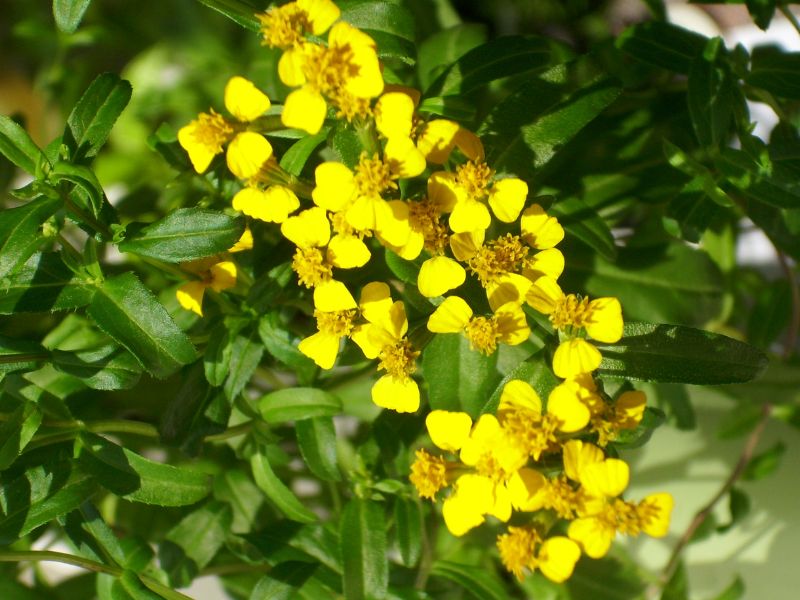
- From Seed
Once all danger of frost has passed in your region, put seeds directly into the ground. Press them into the soil so that they’re just under the surface. Water the soil well and keep it moist as the seeds germinate, which takes about two weeks.
Once the seedlings have emerged and the first set of true leaves have formed, reduce watering so that the top inch of soil dries out in between watering.
Remember that this herb doesn’t like the cold. Anything below 30°F is likely to kill it, so if you want to get a head start on the growing season, you can start seeds indoors about six weeks before the last expected frost date in your area.
Sow seeds in cell plug trays filled with a seed starting medium. You might want to put a few seeds in each cell to ensure that you have a healthy seedling in each one. Just pull any extras that pop up once they are an inch tall or so, leaving one healthy seedling per cell.
Keep the soil moist and reduce watering once the true leaves have formed. Keep the trays in a spot with full sunlight or put them under artificial grow lights for at least six hours per day.
Transplant when the herbs are about six inches tall. Before putting them into your garden, you’ll need to harden them off for about a week.
To do that, take the seedlings outside and put them in a sheltered spot for an hour. Then take them back inside for the rest of the day. On the second day, put them outside for two hours. On the third day, do this for three hours, and so on. After a week, your plant should be ready to stay outside full time.
- From Cuttings

This plant grows readily from cuttings. In the spring, take a six-inch stem cutting and remove the leaves from the bottom half. Fill a four-inch container with potting mix, or you can plant the cuttings directly in prepared soil in the garden.
Dip the cut end in rooting hormone powder and insert it into the soil so that a third of the cutting is submerged below the soil surface. Water well so that the soil feels like a well-wrung-out sponge. Keep the soil about that moist or slightly drier for a few weeks, until the plant forms roots.
You’ll know this has happened if you give the plant a little tug and it resists. At that point, you can transplant outside after hardening off as described above. After you’ve planted outside, reduce watering.
- From Root Divisions
Not only can you create new plants through root division, but it’s a good idea to divide your herbs every few years to maintain them. Dividing helps give the roots more room and encourages compact growth.
In the spring or fall, dig up as much of the plant as you can by digging a few inches wider than the perimeter of the foliage and about a foot down.
Gently work the herb apart so that you have two equal-sized plants. If the roots are being stubborn, you can cut through them with scissors or a gardening knife.
Replant one half back in the original hole and place the other half in a new spot.
- From Layering
Some plants just seem ready to reproduce wherever they touch the ground, and this is one of them. If a branch comes in contact with the soil, it will send out roots.
You can make this work for you by taking a branch that is at least nine inches long and stripping the leaves from the middle. Lay the branch on the soil and lightly cover it with a half-inch of soil.
In a few weeks, give the branch a tug and see if it resists. If it does, cut the stem away from the parent plant and gently dig up the branch and its new roots.
Plant your new herb as you would a transplant.
- From Seedlings or Transplanting
Whether you buy transplants, start your own seedlings or cuttings, or divide plants, at some point you’ll want to transplant these into your garden.
To do this, dig a hole that is twice as wide and as deep as the container the plant is growing in. If you’ve dug up your own layered or divided plant, make the hole twice as wide as the existing root structure.
Gently remove the plant from its container and place it in the hole so that it sits at the same height in the soil as it was in the container or the ground.
Fill in around the hole with soil, and water well to settle the soil and roots.
Pests and Diseases
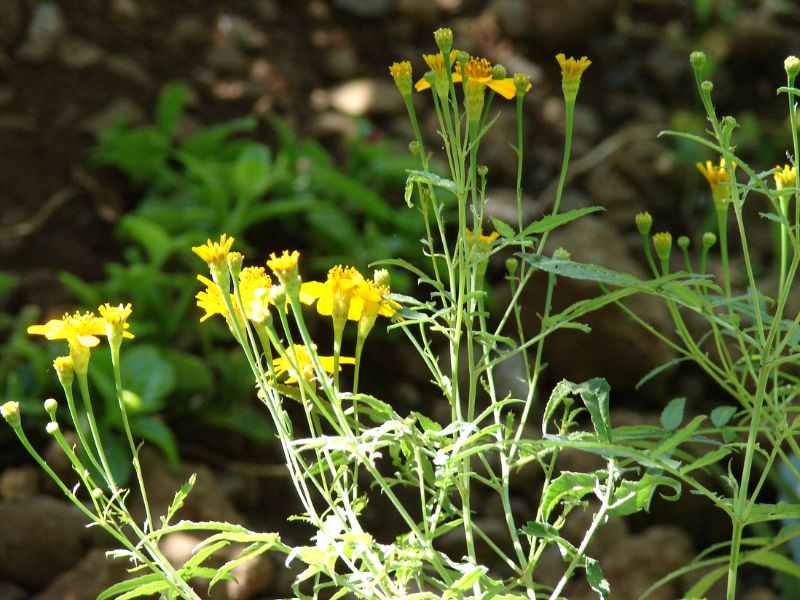
Mexican tarragon doesn’t have a ton of pests and diseases that bother it. In fact, it can actually be used to control many of the common pests that attack vegetable crops.
Take the dreaded root-knot nematode (Meloidogyne spp.), for example. This well-known pest can be incredibly damaging to crops. But T. lucida and other plants in the Tagetes genus may be planted to help control nematodes.
The plant also repels aphids and some types of weevils, and deer and rabbits won’t touch it.
I grew it in the parking strip in front of my house because the area didn’t have any irrigation, and the deer just couldn’t resist taking a swipe at anything and everything I planted there… except yerbis anis.
Having said that, it would be a rare plant that doesn’t have any garden foes, and there’s one type of pest – those slimy little gastropods we all know and hate – that can’t resist sinking their microscopic teeth into Mexican tarragon.
Slugs and snails will make a quick meal out of small plants and can eat quite a bit of foliage off of larger specimens. If you struggle with snails in your garden, read our guide to dealing with snails for some tips.
While I’ve never encountered any signs of disease on my plants, it is possible for them to be impacted by botrytis blight.
This fungal infection is caused by fungi in the Botrytis genus. It’s much more common in plants that are crowded, overwatered, or growing in humid areas, particularly if those areas are also cool (right around 60°F).
If this disease takes hold, you’ll see tiny black dots or gray-colored spores on the plant that blow away in the wind. You might see brown spots on the leaves and foliage may die.
The fungus can overwinter on dead plant tissue, so be sure to clean your gardens up in the fall.
Maintenance
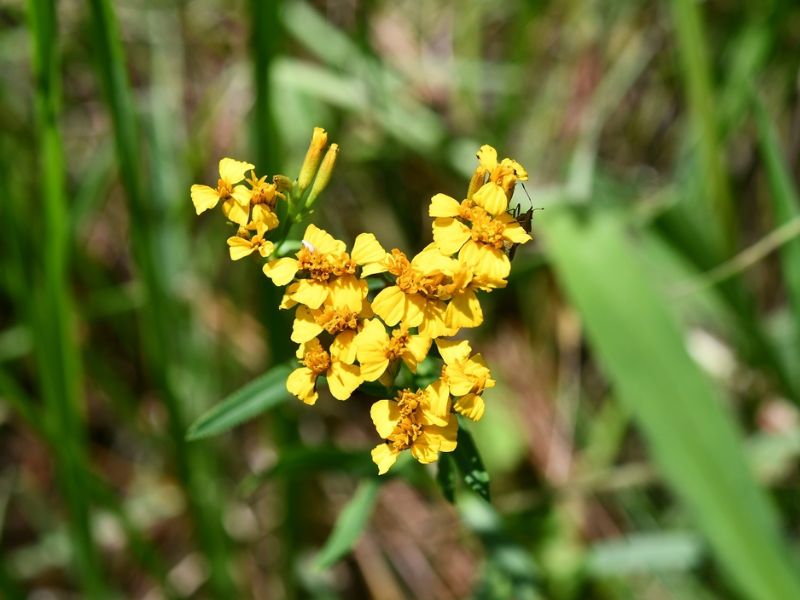
Deadhead regularly if you want to encourage repeat flowering and to discourage plants from going to seed. Divide every few years to improve the health of the plant following the process described above.
Though this plant doesn’t require pruning, you can prune as desired to encourage bushier growth and to create a pleasing shape.
Sweet mace isn’t a hungry plant, but it benefits from regular feedings to encourage lush foliage growth. Feed with an all-purpose fertilizer every other month during the growing season.
III. Uses and Benefits
Tagetes lucida was used by the Aztecs in a ritual incense known as Yauhtli, as well as being dedicated to the rain god Tlāloc. Tagetes lucida is still in use today primarily as a tea to treat the common cold, intestinal gas and diarrhea.
It has been reported that the Huichol of Mexico use the plant as an entheogen by smoking Tagetes lucida with Nicotiana rustica, and that Tagetes lucida is occasionally smoked alone as an hallucinogen. Archaeologists found that the Maya used Tagetes lucida as an additive in tobacco mixtures.
Tagetes lucida also had many culinary uses by the Aztecs including as one of the ingredients added to make the drink chocolatl, which gave it a spicy flavor. Fresh or dried leaves are also used as a tarragon substitute for flavoring soups and sauces. A pleasant anise-flavored tea is brewed using the dried leaves and flower heads. This is primarily used medicinally in Mexico and Central America.
A yellow dye can also be obtained from the flowers, and when the plant is dried and burnt, it is used as an incense and to repel insects.
In one study, methanolic extract from the flower inhibited growth of Staphylococcus aureus, E. coli, and Candida albicans cultures. This effect was enhanced with exposure to ultraviolet light. The roots, stems, and leaves also had the same effect when irradiated with ultraviolet light.
IV. Harvesting and Storage
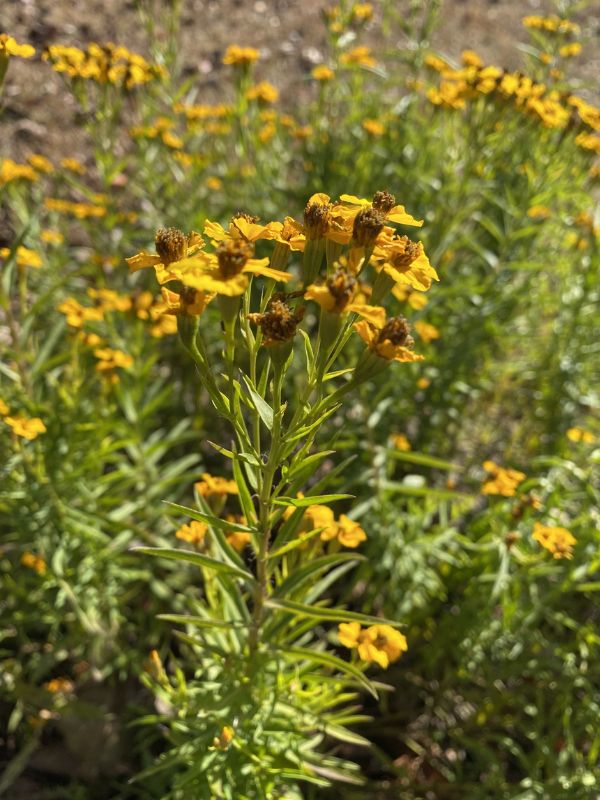
Harvesting
When you’re ready to pick, snip the stems as needed. Plants will branch wherever you cut them, resulting in more abundant and bushier growth.
To harvest the seeds, allow the flowers to turn dry and brown on the plant. Remove them with a pair of clippers, taking care to include the long brown base at the end (that’s the seed pod).
Pull away and throw out any petals that come out readily and then gently rub the dried seed pods in your hands over a bowl. Gently blow away the chaff to reveal the seeds.
Store seeds in a paper envelope in a cool, dry spot until you’re ready to replant next year.
Preserving
The stems and leaves will keep in the fridge wrapped in a paper towel and put inside a plastic bag for about a week.
Dry and grind the leaves into a powder and use it anywhere you would use French tarragon in a recipe.
To dry the leaves, wash them and place them in a cookie sheet on the center rack of the oven on the lowest setting. Let them dry until crisp and brittle when touched, generally for about an hour or two.
You can dry the stems by cutting them at the base and bundling them together. Hang them in a cool, protected area and allow them to dry completely. This can take a few days to a few weeks, depending on your weather and climate.
Strip the leaves from the stem and store them in a glass jar in a cool, dark place.
Find Where to Buy the Best Mexican Tarragon (Tagetes lucida)

















Leave a Reply